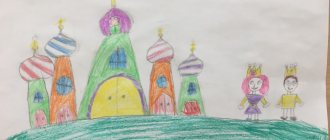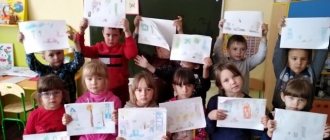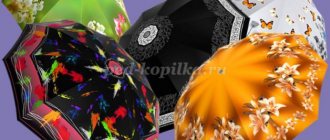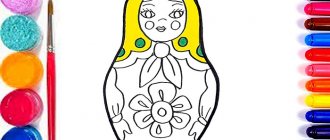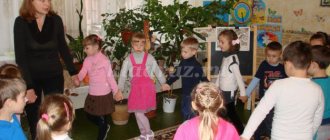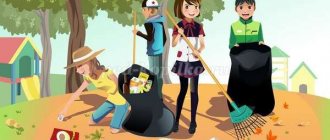Summary of GCD in the preparatory group. In a forest clearing
Summary of GCD in the preparatory group on the topic “In a forest clearing”
Teaching children of senior preschool age to compose descriptive stories based on a subject picture and a supporting plan.
Author: Sidorova Olga Sergeevna, teacher Place of work: MBDOU No. 6 Purpose: Compiling stories and descriptions of insects using subject pictures and a reference plan. Tasks: - activate the vocabulary on the topic;
— clarify the names, external characteristics, structure of insects; — exercise children in selecting definition words for each insect; - practice selecting nouns with diminutive - affectionate suffixes; - practice selecting singular and plural nouns; - practice using R.p. nouns in speech. singular; - teach children to guess insects by the actions they perform; - develop voluntary attention and verbal-logical thinking of children; — to cultivate love and respect for the beautiful places of our native nature and their inhabitants. Equipment: projector, design board; demonstration and handout pictures depicting insects (butterfly, bee, fly, dragonfly, ladybug, ant, etc.); supporting picture plan 6 (illustration 6). Progress of the lesson
The teacher and the children enter the group.
Educator: Children, look how many guests came to us today. Say hello to them. Educator: Children, do you like to solve riddles?
I. Intellectual warm-up
Teacher: Then try to guess my riddle: (tells the children a riddle). The snowball is melting, the meadow has come to life, the day is coming - when does this happen? Educator: Correct. What time of year is it now? Educator: Look at our magic screen, it will help us today. SLIDE 2 Educator: What signs of spring do you know?
(Snow and ice are melting, the days are getting longer, and migratory birds that spent the winter in warm regions arrive.) With the beginning of spring, migratory birds return. Why are they coming back? (There was enough food: insects appeared.) The riddle contains the words: “the meadow came to life,” but what does this mean, how did it “come to life”? (Children talk about sprouting grass and insects appearing.) II.
Main part of the lesson 1. Introductory part. Educator: Today we will take a trip to a forest clearing to look at the insects that live there. Sit down in your seats and imagine that we are traveling on a bus, and to make it not boring, I will tell you about the insects that we are going to observe. SLIDE 3 Bus Insects. There are a great variety of insects on earth. On their abdomen they have transverse stripes, like notches. This is where the name “insects” comes from - from the word “to infest.” Insects are big and small. Some fly, others crawl or jump. Some live for several years, others for one day. Insects have six legs. Their bodies are covered with a hard shell called the exoskeleton. The body of each insect can be divided into three parts: head, thorax and abdomen. They usually have two pairs of wings, although flies, for example, only have one. Insects appear on the surface of the earth only when it is warm - in spring or summer. The bright coloring of many insects warns other animals that they are inedible. Many insects use color to hide from enemies (butterflies, grasshoppers). Birds eat insects. SLIDE 4- 8 Didactic game “Big - small” We have our first stop! Here we will play the game “Big - Small”. I will show you a picture of an insect, you need to name it and think about what its baby will be called. Educator: you completed the task correctly! Let's move on! SLIDE 9 Bus SLIDE 10-14 Educator: How great you are doing. If you like to play, then I have also prepared an interesting game: “One - many.” I will tell you one insect, and you will tell me a lot...” Well done, you completed the task correctly! Let's move on.. SLIDE 15 Bus Educator: Do you know that among insects there are pests - carriers of human and animal diseases; There are also useful ones - they pollinate plants, provide food and raw materials (honey, wax, silk). Sometimes people are compared to insects. Guess what kind of person we can say about: “hardworking like a bee”, “annoying like a fly”. Educator: Next stop: SLIDE 16-17 Look, insects are having fun in this clearing. Look and tell me who is missing? Educator: You coped with this task too. Now we’re going straight to the magic meadow. SLIDE 18 Bus SLIDE 19 An image of a forest clearing appears on the screen. Educator: Here is the forest clearing! But for some reason there is no one in the clearing! Look, guys, who came to us? Children: Scientist cat. Educator: Now we will learn everything from him. Scientist Cat appears: Hello guys. Educator: Hello, Cat. Cat: I decided to ask you riddles and questions. If you can complete my tasks, the insects will stop hiding and return to the forest clearing. Educator: Whoever guesses the riddle and answers the Cat’s questions will receive a picture of this insect. 2. Guessing riddles. Cat: 1. All four petals of the flower were moving, I wanted to pick it, It fluttered and flew away. (Butterfly) SLIDE 10 Question from the Scientist Cat: How does a butterfly eat? (Butterflies land on flowers and feed on their nectar, reaching it with their proboscis.) 2. Housewife flies over the lawn. If he fusses over a flower, he will share the honey. (Bee) SLIDE 11 Question from the Scientist's Cat: Why is this insect so noticeably colored? (The bee, as it were, warns everyone: don’t touch me, otherwise I’ll sting you!) 3. In the summer it flies all day, it gets boring for you, the night will come, then it will stop. (Fly) SLIDE 12 Question from the Scientist's Cat: Why is a fly considered a harmful insect? (She carries dirt and harmful microbes on her paws.) 4. The blue airplane sat on a white dandelion. This is a girl, She has a thin waist, Huge eyes. It flies and chirps. (Dragonfly) SLIDE 13 Question from the Scientist Cat: How many wings and how many legs does a dragonfly have? (She has four wings, six legs.) 5. Forest “bug”, Black head, Wings - red, dots on the wings. (Ladybug) SLIDE 14 Question from the Scientist Cat: Why is the ladybug called that? (She secretes a special orange milk for protection. The bright color reminds the birds that ladybugs are not very pleasant to the taste.) 6. In a clearing near the fir trees, a house is built of needles. It is not visible behind the grass, but there are a million residents in it. They are forest dwellers, friendly builders. (Ants) SLIDE 15 Question from the Scientist Cat: Why are ants called “forest orderlies”? (Ants are beneficial insects. They destroy a large number of harmful insects.) Educator: Let's populate our forest clearing with insects. SLIDE 16 Insects appear on the screen in a clearing. Physical education minute. Attention game "Ant - grasshopper - butterfly." At the command of the teacher “Ant” the children squat, at the command “Grasshopper” they jump, at the command “Butterfly” they “fly”. 3. Compilation of stories and descriptions of insects according to the points of the picture plan. Cat: Children, I will ask you to complete my last task - to write descriptive stories about insects that you remember. After all, all insects are so different! Make up a story about any insect using the pictures from our plan. Educator: Well, guys, let’s complete the task? SLIDE 17 A picture plan appears on the screen. Children write a descriptive story. Cat: Thank you guys, you completed my task, I really liked your stories. But it's time for me to say goodbye, see you guys. And as a parting gift, I want to give you a surprise basket. Goodbye, see you again! Educator: Goodbye Cat, thanks for the surprise basket and see you soon.
Guys, look, all the insects have returned to the forest clearing. And now it’s time for you and me to return home... III. Summing up the lesson
The teacher sums up the lesson, thanks the children for their efforts, and notes the children’s most successful stories.
We recommend watching:
Synopsis of an integrated GCD. Preparatory group Synopsis of the GCD in the preparatory group Synopsis of direct educational activities in the preparatory group on the topic: “Where did I get the Abstract of the open GCD in the preparatory group for OO “Cognition”. Composition of number 7
Similar articles:
Methodological development of direct educational activities in the preparatory group on the topic “Cheerful guys”
Summary of an open lesson on FEMP in the preparatory school group “In a forest clearing”
Summary of an open lesson on FEMP in the preparatory school group “In a forest clearing”
SYNOPSIS of an open lesson on FEMP in the preparatory school group “ON LESNOY PLAYNA ”
TARGET. Continue learning how to do arithmetic problems involving addition and subtraction.
TASKS.
Educational:
1. Improve the skill of composing and solving arithmetic problems involving addition and subtraction.
2. Improve children's counting skills within 10, forward and backward counting.
3. Learn to navigate in a squared notebook.
4. Consolidate children’s knowledge: right, left, top, bottom.
Developmental.
1. Develop logical thinking, imagination, memory, and the ability to independently solve a given problem.
Educating.
1. Cultivate attentiveness, accuracy, perseverance.
2. Foster a caring attitude towards nature.
BENEFITS.
1. Game “Don’t get your feet wet!”
:
“bumps”
- cards with numbers.
2. Problem about frogs: “bump”
- a card with 4 little frogs and a piece of paper with 1 little frog, sets with numbers and mathematical signs.
3. Graphic dictation “Flower”
: a sheet of checkered paper, a simple pencil.
4. «Forest Glade»
:
“flowers - cards”
, stickers with images of insects
(butterflies, dragonflies, bees)
.
5. Counting forward and backward: “flowers”
- cards with numbers.
1. Organizational moment.
guests have come to our
. Let's smile at them
and say hello to them.
You and I should have a math lesson in a group
, but look
what's the weather like outside! I thought: “Shouldn’t you and I go to the forest
clearing
" You and I already know a lot about the forest and its inhabitants. But the forest is not only
dense thicket and bushes. Among the trees there are bright, spacious
glades
on which flowers and herbs grow, various insects live. In the forest
there are large and small glades
.
Spring and summer meadows
covered with green grass.
There are many flowers growing
in .
-Do you want to go to a forest clearing
?
-Then let's remember the rules of behavior in the forest. (You must not break branches or tear
flowers; make noise and shout in the forest. You cannot make fires.) If you will
follow these rules, then the forest will reveal its secrets to you
.
-I must warn you right away that we may meet different
obstacles, trials.
-What will help us overcome these challenges? (Knowledge, skills, ingenuity,
friendship, mutual assistance, helping each other.)
-Well, how? Do you agree?
-Before we start the journey, we need to stretch our fingers.
2. Finger gymnastics “Insects”
.
We count our fingers together - clench and unclench your fists.
We call insects:
Butterfly, grasshopper, fly, alternately bend your fingers into a fist,
Summary of GCD on speech development in kindergarten in the middle group. In a forest clearing
Summary of GCD for speech development. Theme: “Journey to a forest clearing.” Middle group
Goal : to activate children’s speech on the topic “Forest gifts”. Tasks. Learn to answer the questions: Which one? Which? Which? Saturate children's speech with adjectives that denote the properties of objects. Teach them to agree a noun with an adjective. Develop the ability to solve riddles. Encourage children to complement the answers of their comrades. Reinforce the concepts of “edible” and “poisonous” mushrooms. Equipment: envelope (large, bright); hand puppet “bear”, dummies or images of mushrooms (boletus, chanterelles, russula, fly agaric, honey mushrooms); basket. Preliminary work: looking at pictures of mushrooms, clarifying their names, talking about edible and poisonous mushrooms, guessing riddles on the topic “Mushrooms”.
Progress of the lesson.
V-l: Look! We received a letter. What an unusual envelope. Let's tell you what he is like. Children's answers: big, bright, beautiful, painted. V-l: Who sent us the letter? Let's open it and read it. Yes, this is from the forest, from our friend the bear cub. He invites us to visit and asks us to take a gift basket. Here's the basket. What is she like? Children's answers: large, wicker, roomy, etc. V-l: I invite everyone to go to the forest by train. We will be trailers, and Sasha will be the driver. Children place their hands on the shoulders of the child standing in front, forming a train. They move through the group. V-l: here we are. Look who's greeting us! Yes, this is Mishutka! He puts the doll on his hand. Let's tell you what he is like. Children's answers: brown, shaggy, kind, etc. Bear: Hello children! I am very glad to see you! How have you grown? They probably also learned to solve riddles. Listen to the first riddle: I was born on a rainy day Under a young aspen, Round, smooth, beautiful, With a thick and straight leg. (Boletus)
Vs: picks up a dummy mushroom. What a wonderful fungus! Let's tell you what it looks like. Children's answers. V: Children, is this an edible mushroom? Can I put it in the basket? Children's answers. Bear: On a birch stump In a group and individually In September I will find the guys: Identical... (Again)
Vs: Honey mushrooms, what friendly mushrooms! Children, are they edible? Children's answers. Bear: What kind of yellow sisters hid in the thick grass? I see them all perfectly, I’ll take them home soon. A very clean, tasty mushroom - both the cook and the mushroom picker are happy. These yellow sisters are called... (chanterelles)
Vs: Shall we put these mushrooms in the basket? Who can say why we take them? Children's answers: Bear: Even kids know Red and white mushrooms Those that are not friends with flies. Don't take them for dinner - This mushroom is inedible, even though it looks handsome. It has long been called that red mushroom...(fly agaric)
V-l: Oh, what a bright fungus! Shall we put it in the basket? Children's answers: This is a fly agaric. It's poisonous. You can't take it. V-l: Absolutely right. For people it is harmful, but for animals it is medicine. Let's leave him in the forest. Let the animals be treated with it. Bear: Along the forest paths There are many white legs in multi-colored hats, noticeable from a distance. Pack, don't hesitate! This is... (russula)
V-l: Children, are these mushrooms edible? Children's answers: V-l: So our basket is full. What mushrooms did we put there? Children: edible. V-l: let's thank Mishutka for the mushrooms and say goodbye. The children thank and say goodbye. V-l: Children, it’s time for us to return to kindergarten. Let's fly on airplanes. Let's say the magic words: I'll turn around, I'll spin - I'll turn into an airplane. Hands to the sides - these are wings, we start the engines, they hum - they fly. Airfield on the mat. Children move around the group and sit on the mat. Discussion: where we were, who we met, what we received as a gift, what we liked. V-l: I’m very glad that you helped me today and answered all my questions in a friendly manner. Marks the most active. Those who answered few are invited to individual work during the day.
We recommend watching:
Summary of a lesson on speech development in the middle group. Kuban Summary of educational activities on speech development for children in the middle group of preschool educational institutions Summary of a circle lesson in the middle group of a kindergarten on the topic: New Year! How to work with children 4-5 years old with speech impairment at home
Similar articles:
Summary of a game lesson on the topic “Pets” in the middle group
Summary of a lesson on the development of pronunciation in the middle group
Summary of a lesson on speech development “In a forest clearing”
Summary of educational activities for speech development for children of senior preschool age.
Topic: “In a forest clearing.”
Target:
develop the lexical and grammatical structure of children’s speech.
Tasks:
1. Activate children’s vocabulary and speech.
2. To consolidate the use of diminutive forms of nouns, in the correct use of prepositions;
3.Develop children's imagination and creativity.
4. Foster love and respect for nature and its inhabitants.
Methods and techniques
: verbal: conversation, explanation, asking riddles; visual: work with subject pictures, schemes for composing stories - descriptions; practical: independent creative stories for children.
Health-saving technologies: physical education, outdoor classes.
Equipment
: polar bear toy, pictures of forest animals, schemes for writing stories - descriptions.
Preliminary work
: Didactic games on the theme “Wild Animals”, drawing animals, trees. Reading fiction on the topic.
OOD progress.
Introductory part.
Organizing time.
The teacher quietly brings a toy polar bear into the group. Then he draws the children’s attention to the sounds (someone sighs very sadly).
Surprise moment.
Children discover a Polar Bear in the group.
Main part
Teacher (in the voice of a bear) - Hello, guys! I am a Polar Bear. I live in the Arctic, where there is a lot of snow and ice. During classes on getting to know the environment, our teacher, Penguin Lolovich, told me that I have relatives - brown bears and they live in the forest. And I really wanted to visit a clearing in the forest, meet its inhabitants, learn about their families. My teacher said that you can help me with this because... You know a lot about the forest and its inhabitants.
Educator: Are you guys ready to help the Polar Bear? (Children's answers)
- Well done, how can you help the Polar Bear? (You can choose pictures, tell stories, draw pictures, etc.).
— That’s right, guys, and it’s even better if we not only tell you, but also show you the forest and its inhabitants. Do you agree? (Children's answers)
- Then I suggest you get dressed and invite you and our guest to our forest clearing ( the teacher and the children go out to the park area on the territory of the kindergarten
).
Educator: Guys, many different animals live in the forest. Let's try to guess who they are? ( The teacher asks riddles, and after each guessed riddle, puts up a picture of an animal
).
I wear a fluffy fur coat and live in a dense forest.
In the forest on an old oak tree I gnaw nuts ( Squirrel )
.
- Well done guys, place a picture of a squirrel where its house is (children hang the picture on a tree).
